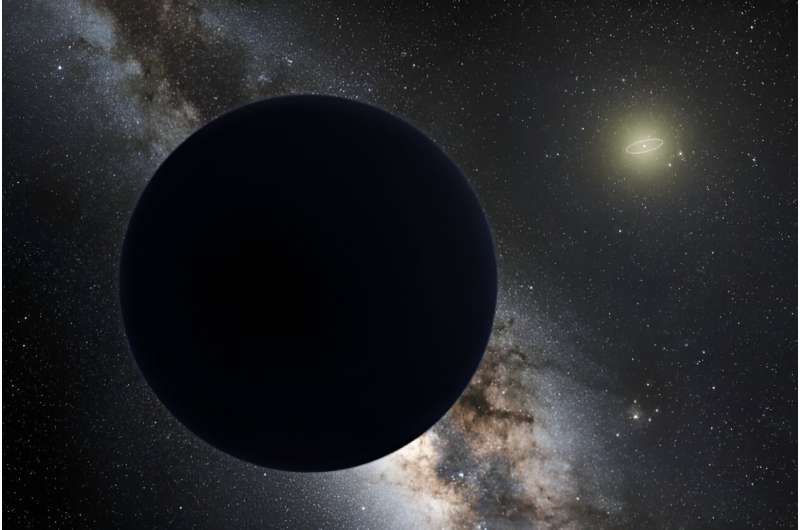This article has been reviewed according to Science X's editorial process and policies. Editors have highlighted the following attributes while ensuring the content's credibility:
fact-checked
trusted source
proofread
There's one last place Planet Nine could be hiding

A study recently submitted to The Astronomical Journal continues to search for the elusive Planet Nine (also called Planet X), which is a hypothetical planet that potentially orbits in the outer reaches of the solar system and well beyond the orbit of the dwarf planet, Pluto.
The goal of this study, which is available on the pre-print server arXiv, was to narrow down the possible locations of Planet Nine and holds the potential to help researchers better understand the makeup of our solar system, along with its formation and evolutionary processes. So, what was the motivation behind this study regarding narrowing down the location of a potential Planet 9?
Dr. Mike Brown, who is a Richard and Barbara Rosenberg Professor of Astronomy at Caltech and lead author of the study, tells Universe Today, "We are continuing to try to systematically cover all of the regions of the sky where we predict Planet Nine to be. Using data from Pan-STARRS allowed us to cover the largest region to date."
Pan-STARRS, which stands for Panoramic Survey Telescope and Rapid Response System, is a collaborative astronomical observation system located at Haleakala Observatory and operated by the University of Hawai'i Institute of Astronomy. For the study, the researchers used data from Data Release 2 (DR2) with the goal of narrowing down the possible location of Planet Nine based on findings from past studies.
In the end, the team narrowed down possible locations of Planet Nine by eliminating approximately 78% of possible locations that were calculated from previous studies. Additionally, the researchers also provided new estimates for the approximate semimajor axis (measured in astronomical units, AU) and Earth-mass size of Planet Nine at 500 and 6.6, respectively. So, what are the most significant results from this study, and what follow-up studies are currently being conducted or planned?
"While I would love to say that the most significant result was finding Planet Nine, we didn't," Dr. Brown tells Universe Today. "So instead, it means that we have significantly narrowed the search area. We've now surveyed approximately 80% of the regions where we think Planet Nine might be."
In terms of follow-up studies, Dr. Brown tells Universe Today, "I think that the LSST is the most likely survey to find Planet Nine. When it comes online in a year or two it will quickly cover much of the search space and, if Planet Nine is there, find it."
LSST stands for Legacy Survey of Space and Time, and is an astronomical survey currently scheduled as a 10-year program to study the southern sky and take place at the Vera C. Rubin Observatory in Chile, which is presently under construction.
Objectives for LSST include studying identifying near-Earth asteroids (NEAs) and small planetary bodies within our solar system, but also include deep space studies, as well. These include investigating the properties of dark matter and dark energy and the evolution of the Milky Way galaxy. But what is the importance of finding Planet Nine?
Dr. Brown tells Universe Today, "This would be the 5th largest planet of our solar system and the only one with a mass between Earth and Uranus. Such planets are common around other stars, and we would suddenly have a chance to study one in our own solar system."
Scientists began hypothesizing the existence of Planet Nine shortly after the discovery of Neptune in 1846, including an 1880 memoir authored by D. Kirkwood and later a 1946 paper authored by American astronomer, Clyde Tombaugh, who was responsible for discovering Pluto in 1930.
More recent studies include studies from 2016 and 2017 presenting evidence for the existence of Planet Nine, the former of which was co-authored by Dr. Brown.
This most recent study marks the most complete investigation of narrowing down the location of Planet Nine, which Dr. Brown has long-believed exists, telling Universe Today, "There are too many separate signs that Planet Nine is there. The solar system is very difficult to understand without Planet Nine."
He continues by telling Universe Today that "…Planet Nine explains many things about orbits of objects in the outer solar system that would be otherwise unexplainable and would each need some sort of separate explanation."
"The cluster of the directions of the orbits is the best know, but there is also the large perihelion distances of many objects, existence of highly inclined and even retrograde objects, and the high abundance of very eccentric orbits which cross inside the orbit of Neptune. None of these should happen in the solar system, but all are easily explainable as an effect of Planet Nine."
More information: Michael E. Brown et al, A Pan-STARRS1 Search for Planet Nine, arXiv (2024). DOI: 10.48550/arxiv.2401.17977
Provided by Universe Today





















